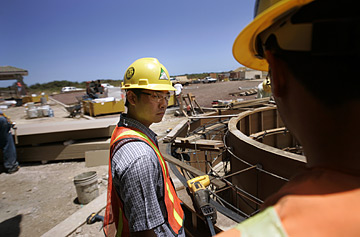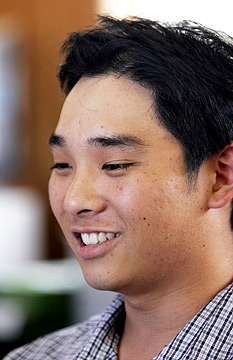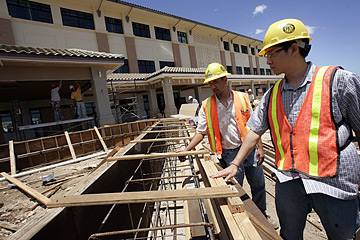
RICHARD WALKER / RWALKER@STARBULLETIN.COM
Kelsey Ho, a Punahou graduate who is attending Carnegie Melon University in Pittsburgh, works as an intern with Kiewit Building Group at the job site of the new Pacific Academy High School in Kapolei. Ho was recruited on the mainland and brought home for the summer.
|
|
Laboring for workers
Employers are finding that it pays to jump-start recruitment by offering internships, especially to Hawaii students or those with local ties
IT'S SUMMERTIME and Kelsey Ho, a 19-year-old student at Carnegie Melon University, has returned home to spend plenty of time in the sun.
But unlike many of his peers, the 2005 Punahou graduate and Eagle Scout is accruing most of his outdoor time on the job as an engineering intern for
Kiewit Building Group Inc.
Based at the construction site for Island Pacific Academy's new high school, Ho is helping expand the school along with his post-degree career opportunities in Hawaii.
Ho is just one of several kamaaina college interns that Kiewit has recruited on the mainland and brought home for the summer. The construction firm, which has had to contend with severe labor shortages in the midst of economic expansion, has added 20 percent to its work force development budget and ramped up recruitment efforts to fill internships with kamaaina kids, said Lance Wilhelm, senior vice president at Kiewit Building Group. While Kiewit will consider any qualified worker for positions, the company has found that the best fit is usually kamaaina kids, either living here or on the mainland, he said.

RICHARD WALKER / RWALKER@STARBULLETIN.COM
Kelsey Ho, 19, is interning with Kiewit Building Group to expand his post-degree career opportunities.
|
|
"It's pretty easy to go to the mainland and convince kids who grew up in New Jersey that Hawaii is a cool place to work. We can always get people to come, but can we get people to stay?" Wilhelm said. "Hawaii kids tend to work out better because they have connections and they want to be here."
The unprecedented growth of Hawaii's construction industry, combined with the state's tight labor market, has made it difficult for employers like Kiewit to find and retain a solid work force. Improved economic times have begun to bring local talent back to Hawaii after the mass exodus of talent in the 1990s, but despite the turnaround, many expanding island businesses have still felt the burn of trying to grow in a small market.
At a time when many businesses have had to turn away jobs or close up shop because of work-force limitations, Hawaii's smartest employers are finding that it pays to jump-start recruitment by offering internships, said Rick Varley, director of internships and career development for the University of Hawaii's College of Business.
When it comes to internships, Hawaii students or those with Hawaii ties are in the most demand, Varley said.

RICHARD WALKER / RWALKER@STARBULLETIN.COM
Kelsey Ho, right, an intern with Kiewit Building Group, and Alika Fujimoto, a superintendent for Kiewit, do a walk-through inspection of the job site of the new Pacific Academy High School in Kapolei. While Ho can expect to receive plenty of mainland offers when he graduates, Kiewit has kept returning to Hawaii a viable possibility.
|
|
The number of internships offered to UH students has grown from 25 to 30 a semester in 1999 to more than 175 per semester, he said.
"Five years ago, we were begging companies to take interns. Now it's the opposite -- they're inviting us to lunch," Varley said. "We've got about 1,000 internships open right now."
Internship opportunities have become so prevalent in Hawaii that employers have found staffing them can be just as competitive as filling permanent jobs, he said.
"I have 80 marketing internships and only 25 to 30 students available," Varley said. "It's a competitive environment for employers. You have to provide an awfully good internship experience or you have to pay the students."
Even before they are ready to hit the work force with diploma in hand, students like Ho are finding that Hawaii's job market has plenty to offer. Employers are now routinely offering workers higher wages, better benefits, greater flexibility and an opportunity to fast track their careers.
"I tell the students to thank their parents for their impeccable timing," Varley said. "This job market is the best that we have had in a long time."
Hawaii's competitive labor market has created a pressure-cooker environment for many employers, said Judy Bishop, president of Bishop & Co., a Hawaii-based staffing firm.
"The environment out there is just terrible. People have closed their companies down because they can't find workers in various locations," Bishop said. "And some construction firms have been declining projects because they don't have enough workers."
Since many island employers don't have a large enough pool of workers to choose from in Hawaii, it has become necessary for most to recruit on the mainland, said Jon Sakurai-Horita, president of Kamaaina Careers (www.Kamaaina-careers.com), an online job service that helps link kamaaina with Hawaii companies.
"Hawaii companies have always had an interest in hiring someone with a local tie because someone with a local tie is more likely to stay in Hawaii than someone without that support network," Sakurai-Horita said. "But lately, there's been a lot more interest. The employer marketplace is tight and they are definitely looking for talent."
The prospect of the chance to get real-world experience is what has brought Ho back for a second internship with Kiewit, whose philosophy is baptism by fire. Wilhelm, who has spent 18 years with Kiewit, said the company strives to provide young people with leadership and development opportunities.
"I started in accounting and they taught me the engineering side of the business," Wilhelm said. "When this company bets, we bet on people."
Kiewit's internship is designed to expose interns to various segments of the industry for three summers, he said. At the end of the experience, 90 percent of the company's interns end up accepting jobs, Wilhelm said.
"The work that they do is hard. It's demanding," he said. "If an intern is willing to put in the time, it says a lot about their caliber."

RICHARD WALKER / RWALKER@STARBULLETIN.COM
Kelsey Ho, left, and Alika Fujimoto, a superintendent for Kiewit Building Group, survey the interior of a building of the new Pacific Academy High School in Kapolei.
|
|
At Kiewit, Ho is treated like any other employee, Wilhelm said. He's got a job to do and he's expected to use the tools and resources at his disposal to get it done right, he said.
"It's tough to know that so much is riding on my decisions, but I've gotten more confident as the job has progressed," Ho said.
While Ho can expect to receive plenty of mainland offers when he graduates, Kiewit has kept returning to Hawaii a viable possibility, he said.
"Coming back to Hawaii is something that I'd like to do if I can afford it," Ho said. "I enjoyed growing up here, and when the time comes to have my own family I would like to provide my children with the same type of experience."
Kiewit provided the opportunity for Alika Fujimoto, 29, to return home to Hawaii after finishing a stint with the company in Seattle following his graduation from the University of Washington.
"When I graduated, there was nothing available in Hawaii, but I took the job with Kiewit because I knew it offered a chance to come back," said Fujimoto, who supervises the company's interns in Hawaii and was recently named site superintendent for the $9 million expansion of Island Pacific Academy.
In the years since college that Fujimoto has been building his career, the employment climate in Hawaii has changed, he said. Now it's employers who are at the mercy of the students, Fujimoto said.
"Most of Hawaii's students have plenty of offers lined up on the mainland where the pay is better and the cost of living is lower," Fujimoto said. "Sometimes, it's hard for them to make the decision to come back. We have to give them a reason."

